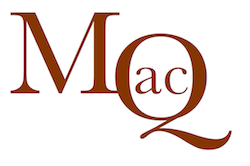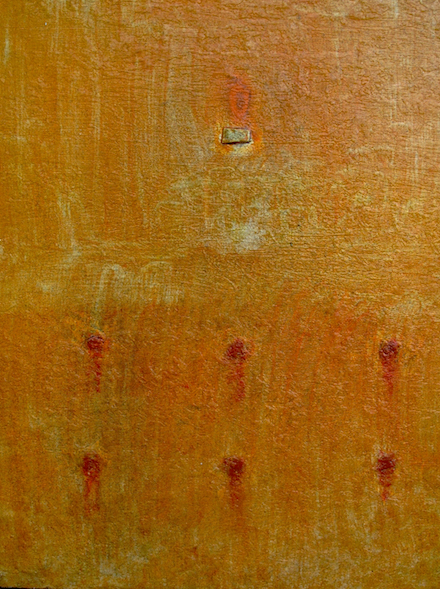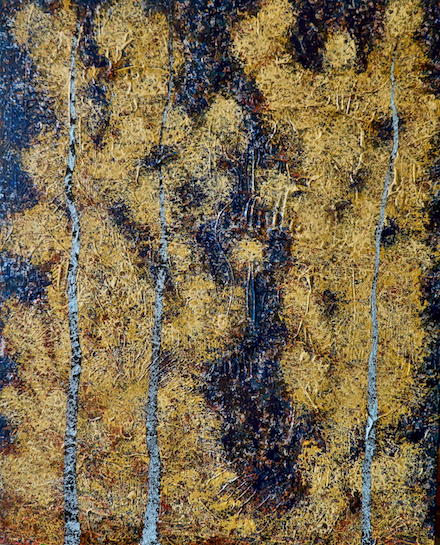
|
|
|
|
|
| Issue 27: | March 2025 |
| Essay: | 1,598 words |
| + Footnotes: | 434 words |
Essay and Visual Artworks
by Kendall Johnson
Writing for Vision, Part 7
Vision

For Our Sins (2006-17) copyrighted © by Kendall Johnson1
Suddenly we find we are dancing along an abyss of growing darkness. Today’s human world is drowning, burning, and starving from its own success. At the same time effective collective action against these real threats is hobbled by those with personal agendas, fears of the unknown, or unwillingness to imagine that things could be otherwise. Fear and greed blind and misdirect. What do we do when our “collective will” has turned into a discordant “won’t”?
A dozen empirically verified existential threats loom as we prove ourselves unable to manage ourselves: nuclear proliferation in a volatile world, ancient hatreds and blame inciting new violence, tempests in political teapots, widespread cynicism and distrust resulting in “me first” attitudes, disbelief in law and order, displacement of fear and rage, disregard of truth and honesty. And in the midst of all this, we teeter in the face of uncontrolled climate breakdown. We are rapidly losing our oxygen, fresh water, food sources, and arable land. The earth will evolve, but it isn’t so clear that we will. The possibility is dawning upon the more sensible of us that we may be ineptly stumbling into our own extinction. As individuals, parents, and leaders, as souls seeking to discover and create our destiny, what do we do now, when we can’t seem to save ourselves?
Lending Perspective
Some years ago I was called to a situation in disarray. The small fire had run up a watershed outside a small mountain town near Lake Tahoe on the eastern side of the Sierra Nevada. Firefighters attacked the fire, pursuing it up a steep slope of timber. The fire slowed at the top of the rise, and appeared to lie down. A lookout was posted to keep an eye on things while the crews mopped up. The engines returned to the station.
During the night the winds shifted; the fire revived, and ran the rest of the way upslope to the ridge and down the other side of the mountain. Two other wind shifts occurred during the night, the first causing the fire to run left up the valley perpendicular to its original direction away from town, gaining momentum and size. The third shift in wind blew the fire left again, back over the ridge, and down into the town below. When the news teams arrived in the early morning, half the town was gone.
It turns out that when the fire first appeared to have died down, its continued burning was obscured by a thick pocket of smoke that diminished the oxygen and slowed the burn, but also the firefighters’ vision. More lookouts had been necessary, from more directions. The moral: not only does smoke get in your eyes, it keeps you from seeing clearly. We often need to take a step back, gain perspective, and look again.
Seeing Through Smoke
Like the “fog of war,” the various distractions (some real, many contrived) that have led to our current national and global circumstances—political, economic, and ecological chaos—have also created a sense of personal anxiety, desperation, depression, and hopelessness. The world is on fire and we are running in circles of fear and anger that make things worse. Hope requires fresh vision. Scientists and leaders of compassion are doing what they can, but it turns out that vision is what creators have the skills and resources to do best.
This is obviously not news. Picasso’s mural Guernica,2 the tone poem Finlandia by Sibelius,3 and Haydn’s Mass in Time of War4 were created in protest against terrible circumstance. And each has outlived the governments and wars that formed their backdrops. To be clear, however, the importance of each is less how the piece became as timeless as art can become, nor the prestige it brought its composer or painter. The real importance of those pieces lies in how they helped those who saw and heard them at the time, in the midst of brutal circumstance. Did those affected by the work feel themselves less alone?

Fall Lightning (2023) copyrighted © by Kendall Johnson5
Implications for Writers
You and I have a job to do in these perilous times. If we as a people are to survive this Anthropocene Age,6 our job now is not to make more money, not to buy more stuff, not to gain status, or great ratings. Applauding cynicism, and exploiting others, have gotten us where we are by ignoring or obscuring the real dangers. As the previous essays in this series have repeatedly pointed out, real creators are needed right now. It is time to sharpen our expressive skills, not for our own gain, but instead in service to the world. Here is how we can help. We can ...
1. Say Things Effectively
Be it poetry or prose, fiction or nonfiction, our writing, like visual art, can speak directly through aesthetic perception. Writing through the body, trusting our own subjectivity and anchoring our message in the ways we all gain knowledge best, can provide an altogether different way to look at the world—addressing other realities as well as emotions and spirit, and satisfying deeper human needs.
Dear Source Within: Help me to remember that it is when things are grim that I must reach out to comfort those who most need our support. I must look past surface bluster.
In difficult times, when resources and support run thin, creators are called beyond ornamentation and professional prestige. The great irony of the times is that now, a time when we can expect the least support, is when we are needed most.
2. Talk About What Matters
Nearly a decade ago, in writing and painting about the wild hillside close by my home, I focused upon my early memories of the place, its personal meaning to me, its history and function for the broader community. All this matters less than the way we all can learn to look at it now. Seeing it anew is a critical step in rebuilding our deeper souls that have been ravaged by the growing darkness. My work must focus upon the bits of sublime beauty that still exist within that backdrop, and can be appreciated and nurtured. I can share the sublime beauty that remains.
Dear Source Within: Help me to remember to look for hidden truth, beyond distractions. I must always look beyond what is assumed.
In pointing out sublimity, I must show more than objective beauty. In my telling the story of the place, I must do so within the shifting toxic background of the unfortunate now. Perhaps “sublime” should point to the act of creating more than that which was created. It may be that the main message of Tonalist artists to writers of today is based less upon what we should write, than the “why and how.” More about our purpose, the way we approach our writing, and how it feels to write our most important work. The Tonalists teach us to write what matters to each of us personally, existentially; write what has not been said enough, not just what we think will impress others. Therein lies authenticity and our own true voice.
3. Find Strength in Purpose
Don’t beat your audience over the head with preaching and polemic. There is more than enough polemicism going around, and part of today’s cynicism has developed in response to the constant blitz of untrustworthy persuasion, diversion by contrived spectacle, and continual propaganda over the airways and across the back fence. Notice how imagist poets and abstract artists trust their viewers. Let your audience draw their own conclusions about your veracity and message; listen to your own heart and make yourself sing. Therein lies truth, authenticity, and your own clarion voice. Only that voice can reach others deeply, through being your truth.
Dear Source Within: Help me to remember that what I believe matters, and how I treat others, even more. I must listen to the unexpected voices.
4. Seek Out Light
Our personal capacity for our own, authentic truth may provide a clue to our source of purpose. Might not those of us who have the capacity, also have the reason to point out the beauties—not just the injustices or ironies—that still remain? Against the sundry existential threats we all currently face, those things which we find of value and beauty take on a precious, almost surreal glow. Others around us need to be shown that hope. Until we reach whatever our personal outcomes may be, that glow can still be shared. We must write for, not just to, our readers, and help them make space for courage and hope.
Dear Source Within: Help me to remember that the flow of the deep wild leads to new star systems. I must look for unexpected paths revealed.
To seek out the beauty around us, especially when we are losing light, to stay awake and notice, that is what we can still do. We can remain sensitive to seeing what is revealed to our hearts, what still glows in this changing light. We can search for the meaning before us, for that is what we do.
And significantly:
We can remember to breathe. When we do that, and using whatever expressive skills and talents we bring to task, we can remind those around us to breathe, to see, to allow the joy to come back in. This is our ultimate resistance. This is what we can do for the world and those we love, and for ourselves as well, against the gathering dark.
Citations and Author’s Notes:
Links were confirmed on 21 March 2025.
- Kendall Johnson. For Our Sins (2006-17). Acrylic on canvas (24″x18″). Unpublished.
- As Johnson notes: Picasso painted Guernica in response to Hitler’s bombing of the Spanish town Guernica in support of the dictator Franco. For background information, please see the link in the next paragraph below.
Editor’s Note: The Picasso article has numerous space-hogging links to advertisements, which may or may not be obvious at first glance. When I first accessed the website, one such misleading link preceded the text of the article. To reach the beginning, please scroll down. “Guernica, 1937 by Pablo Picasso” at PabloPicasso.org:
https://www.pablopicasso.org/guernica.jsp#google_vignette
Also, Stephen Holmgren’s blog, Toward Beauty, has a good rendition of the mural (large and fairly accurate), accessible when you click on the image at the top of the blog post “The Beauty of Picasso’s Guernica” (26 February 2022):
https://towardbeauty.org/2022/02/26/the-beauty-of-picassos-guernica/ - As Johnson notes: Jean Sibelius composed Finlandia, Op. 26 (1899) in response to Russia’s invasion and occupation. For more information, please see Georg Predota’s discussion “On This Day 2 July: Sibelius’ Finlandia Was Premiered” in Interlude (2 July 2022):
https://interlude.hk/on-this-day-2-july-sibelius-finlandia-was-premiered/
A portion of this tone poem may be experienced at YouTube (see link below). NOTE: The piece is dark. My first exposure to it was in Los Angeles, seven years after my return from Vietnam combat. The piece goes deep, and I still haven’t quite recovered.
https://www.youtube.com/watch?v=qOSaT6U4e-8&t=90s - As Johnson notes: Haydn composed the Mass, which premiered on 26 December 1796, in anticipation of Napoleon’s invasion of Austria. For background information, please see Martin Pearlman’s Program Notes for Boston Baroque’s performance of “Joseph Haydn: Missa in tempore belli (Mass in Time of War)” (22 February 1991):
https://baroque.boston/haydn-mass-in-time-of-war/#program-notes
This Mass is also known as the “Paukenmesse” or “Kettledrum Mass.” Several videos of performances are available at YouTube, including this one with Leonard Bernstein conducting the first movement, the Kyrie:
https://www.youtube.com/watch?v=yLr5qiUjOq4 - Kendall Johnson. Fall Lightning (2023). Acrylic on canvas (30″x24″). Unpublished.
- As Johnson notes: Some scientists argue that our era is the “age of humans,” characterized by a loss of biodiversity paralleled only five times before on earth. The last time this occurred, the dinosaurs were wiped out. If we keep up our present mindless pace, they argue, we humans may end up the next dinosaurs in the Sixth Mass Extinction. For details, see “Welcome to the Anthropocene”:
https://populationmatters.org/welcome-to-the-anthropocene/
Publisher’s Notes:
1. The first six essays of this Writing for Vision series by Kendall Johnson also appear in MacQueen’s Quinterly:
Part 1: Interior Lighting: Abstraction and the Concrete, Issue 23 (28 April 2024)
Part 2: Grounding: What Land Art Tells Us of the Long Walk Home, Issue 24 (30 August 2024)
Part 3: Seeing Beyond the Clamorous Now, Issue 25 (22 September 2024)
Part 4: Fields of Vision, Issue 26 (1 January 2025)
Part 5: Losing Light, Issue 26 (1 January 2025)
Part 6: Slanting Light: Voicing the New Wild, Issue 27 (March 2025)
2. On a related note: The six essays of Johnson’s Writing to Heal series are published in MacQueen’s Quinterly online (Issues 16-19, 20X, and 22), as well as in a printed collection released by MacQ in May 2024. The book also includes a few of his poems and 21 of his artworks in full color, as described in Issue 23 of MacQ:
Writing to Heal: Self-Care for Creators
| Copyright © 2019-2025 by MacQueen’s Quinterly and by those whose works appear here. | |
| Logo and website designed and built by Clare MacQueen; copyrighted © 2019-2025. | |
|
Data collection, storage, assimilation, or interpretation of this publication, in whole or in part, for the purpose of AI training are expressly forbidden, no exceptions. |
At MacQ, we take your privacy seriously. We do not collect, sell, rent, or exchange your name and email address, or any other information about you, to third parties for marketing purposes. When you contact us, we will use your name and email address only in order to respond to your questions, comments, etc.